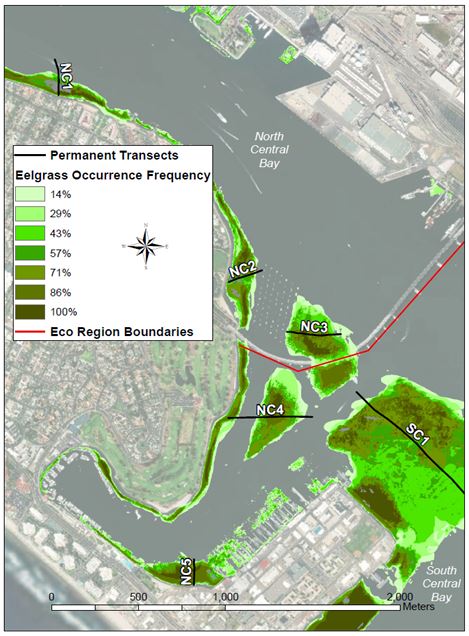
As environmental champions of San Diego Bay, the Port of San Diego announces a new partnership with the United States Department of Transportation’s Maritime Administration’s (MARAD) META program to study baywide eelgrass carbon sequestration. The META program promotes the research, demonstration, and development of emerging technologies, practices, and processes that improve maritime industrial environmental sustainability.
Eelgrass and other coastal “blue carbon” ecosystems have a unique ability to rapidly capture and hold large amounts of carbon dioxide in their plants and soils. Like all plants, eelgrass absorbs carbon dioxide (CO2) and produces oxygen. Unlike land plants though, eelgrass is submerged in saltwater, which prevents the release of CO2 back into the atmosphere. The carbon is trapped in the eelgrass plants and soils for thousands of years. Even though eelgrass habitats cover a small fraction of the area forests on land do, they can store carbon at rates 30 to 50 times greater than forests.
Evaluation of Temporal and Spatial Changes of Eelgrass Beds Within San Diego Bay Using Permanently Monitored Transects (2019‐2020)

In San Diego Bay, eelgrass is a heavy hitter when it comes to its potential to store carbon. The bay supports 17% of all eelgrass in the state and half the eelgrass found in Southern California. Eelgrass is one of the least-studied coastal ecosystems. More research is needed to understand how much carbon eelgrass can store and how eelgrass can support efforts to mitigate greenhouse gas emissions.
MARAD has awarded the Port of San Diego a $150,000 cooperative agreement for a one-year study to assess how much carbon is stored in San Diego Bay’s eelgrass and how much carbon eelgrass will continue to capture into the future. Information from this pioneering study will help the San Diego region better understand the carbon sequestration benefits of healthy eelgrass and how restoring or enhancing eelgrass could help mitigate greenhouse gases.
“We need to consider all options in supporting state and local climate planning efforts, and a better understanding of eelgrass carbon sequestration in San Diego Bay could unlock a treasure trove of information and possibilities,” said Port of San Diego Board of Port Commissioners Chairman Michael Zucchet. “This study and partnership with MARAD is part of the Port’s holistic approach to mitigating greenhouse gases and helping us meet State requirements and the goals we’re setting in our own Maritime Clean Air Strategy.”
“MARAD is very pleased to support projects such as this one that will advance the research needed to support attainment of the ambitious goals for decarbonizing the maritime sector set forth by the Administration,” said Lucinda Lessley, Acting Maritime Administrator. “We look forward to seeing the results of this work and will also provide vital information to support natural habitats.”
This study is a vital component to the Port’s ongoing efforts to protect all the important resources tidelands provide to our region, and support state and local climate planning efforts. This study also complements the Port’s growing portfolio of nature-based solution projects:
- Blue Economy Incubator projects– San Diego Bay Aquaculture, ECOncrete, and Sunken Seaweed.
- Pond 20– an 85-acre wetland mitigation bank to restore coastal saltmarsh habitat with the added benefits of carbon sequestration, ecological enhancement, among others.
- Native Oyster Living Shoreline Project– creating oyster reefs to recruit native oysters, prevent shoreline erosion, and help with carbon sequestration.
- Restorative Aquaculture Planning – initiating the planning effort to permit seaweed and shellfish farming for restorative benefits, such as water quality improvements, biodiversity enhancement, and carbon sequestration.
Evaluation of Temporal and Spatial Changes of Eelgrass Beds Within San Diego Bay Using Permanently Monitored Transects (2019‐2020)





